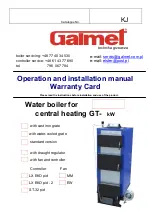
Important
Failure to install the condensate discharge pipework correctly will
affect the reliable operation of the boiler.
Careful consideration must be given to the possibility of the
pipework being subject to freezing conditions and appropriate
measures taken to prevent blockage. Correct installation in
accordance with this section will considerably minimise the
likelihood of blockage and subsequent boiler lock-out.
A condensate discharge pump and pipe "Trace Heating" are
available as accessories.
The condensate discharge pipe MUST NOT RISE at any point
along its length. There MUST be a fall of AT LEAST 2.5° (50mm
per metre) along the entire run EXCEPT when employing a
suitable condensate pump in basement and cellar or similar
applications.
The boiler condensate trap incorporates a seal of 75mm, therefore
it is unnecessary to install an air break and trap in the discharge
pipework.
The condensate outlet will accept 21.5mm (
3
/
4
in) plastic overflow pipe. It is
strongly recommended that this discharges internally into the household
drainage system. Where this is not possible, discharge into an outside
drain is permissible providing every possible precaution is taken to prevent
freezing.
Ensure the discharge of condensate complies with any national or local
regulations in force. BS 6798 & Part H1 of the Building Regulations give
further detailed guidance.
The discharge pipe should be run in a proprietary drain pipe material e.g.
PVC, PVC-U, ABS, PVC-C or PP.
Metal pipework is NOT suitable for use in condensate discharge systems.
The pipe should be a minimum of 21.5mm diameter and must be
supported using suitably spaced clips of the correct design to prevent
sagging.
It is advisable that the full length of condensate pipe is run internally and
preferably be less than 3 metres.
Internal runs greater than 3 metres or runs in cold areas should use 32mm
waste pipe.
External runs MUST be a MINIMUM of 32mm and fully insulated with
material suitable for external use.
If the boiler is fitted in an unheated location the entire condensate
discharge pipe should be treated as an external run and sized and
insulated accordingly.
In all cases discharge pipe must be installed to aid disposal of the
condensate. To reduce the risk of condensate being trapped, as few
bends and fittings as possible should be used and any burrs on cut pipe
removed.
When discharging condensate into a soil stack or waste pipe the effects of
existing plumbing must be considered. If soil pipes or waste pipes are
subjected to internal pressure fluctuations when WC's are flushed or sinks
emptied then backpressure may force water out of the boiler trap and
cause appliance lockout.
A boiler discharge pump is available which will dispose of both condensate
& high temperature water from the relief valve. It has a maximum head of
5 metres. Follow the instructions supplied with the pump.
Condensate Drain Pipe "Trace Heating" Elements are available in various
lengths, 1, 2, 3 & 5 metres. Where the drain is between 3 & 5 metres a 5
metre kit can be used and "doubled back" upon itself.
It is possible to fit the element externally on the condensate drain or
internally as detailed in the instructions provided.
Fig.15
Methods of termination continued
PN-0000455
E
3
5
F
G
3
3
5
5
7
7
10
11
11
10
12
6
5 Before installation
28
















































